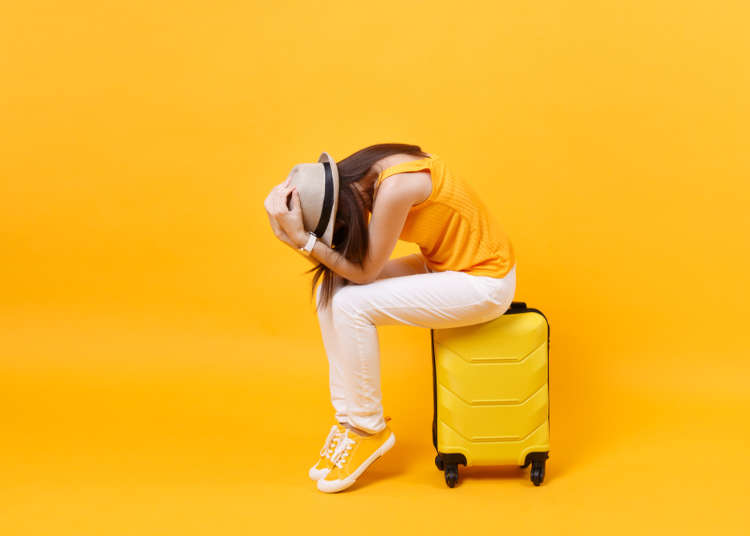
During their stay in Japan, foreigners often worry about how to respond to a natural disaster. Whether it's your first time visiting a country that experiences typhoons and earthquakes regularly, or you simply want to know the procedures in another country - it can be scary to think about!
That’s why we asked a few foreigners to tell us their worries about if a disaster were to hit Japan. We will also explain a bit about how to deal with each of their concerns.
(Below are the personal opinions of those who responded to the survey).
In this article:
・What Worried Our Chinese Participants
・How to Handle These Issues
・What Worried Our European Participants
・How to Handle These Issues
What Worried Our Chinese Participants

The following points were raised as causes for concern in the survey given to Chinese people.
1) About doctors and pharmacists who can speak foreign languages
I can’t speak Japanese, so I don’t think I can communicate my ailments and symptoms well. Also, if I were allergic to a particular drug, there’s no way of knowing if I could take the prescribed medicine. I think it would be a relief to know where the multilingual hospitals and pharmacies are.
2) About dietary restrictions
Certain foods are forbidden for religious reasons. In the unlikely event of a disaster, I might not be able to consume the food distributed at the shelter. It could be very troublesome.
3) About transport information during a disaster
During disasters, trains and buses often become temporarily unavailable. It would be helpful if there was a website that could check and announce the operation status of each transportation facility in real time.
Several angles were raised in the survey given to Chinese people. What kind of countermeasures can be considered in each case?
How to Handle These Issues
1) Doctors and pharmacists who can speak foreign languages
Please refer to the following services provided by the Japanese National Tourism Organization (JNTO) to find medical facilities that accommodate foreign languages. On this site, you can find medical facilities accepting foreign tourists in English, Korean, and Chinese (Traditional and Simplified). As of 2018, 1,255 institutions have been registered in the site, and the number of registered facilities is expected to increase over time.
In addition, the “How to use a medical institution” section contains information such as “How to call an ambulance” and “Procedure from hospital reception to payment”. You can find a lot of useful information here.
If you are allergic to certain medications, write them down and carry the list with you, and make sure to present it during a checkup. You should be able to expect a smooth exchange with a doctor who can speak in a foreign language.
2) Dietary restrictions
If there are certain foods that you can't eat due to religious reasons or allergies, use the Inbound Correspondence Guidebook for Restaurant Owners issued by the Ministry of Agriculture, Forestry and Fisheries. On page 48 of this guidebook, there is a checklist for allergies and food that you can’t eat. This list shows typical ingredients so you can point the ones that can trigger allergies or the ones that you can’t eat for religious reasons.
Because the information can be conveyed by just pointing at the images, you can expect a very smooth communication even if you can’t speak Japanese. This sheet could particularly be of great help when eating at a restaurant.
3) Transport information during a disaster
During a disaster, you will want to be able to check transport information for buses and trains as soon as possible. In this situation, we provide our own “Transport Information” here at LIVE JAPAN. You can check the operation status of railways, airports, airlines and buses nationwide.
There is also a lot of disaster-related information such as “What to do during an earthquake” and “What to do during a typhoon”, so this will definitely be useful during an emergency. It’s best to save this website to your bookmarks when visiting Japan!
What Worried Our European Participants

The following points were raised as causes for concern in the survey given to Italian people.
1) About access to the embassy
If I am traveling just for a few days, I usually wouldn't check in advance, but in an emergency, I’d want to know immediately where the embassy is. How can I find information on access to the embassy?
2) About the means of communication during a disaster
I think that mobile phones wouldn’t be able to connect for a while after a disaster. What should I do if I wanted to make an international call in such a situation?
3) About detailed information on the evacuation site
I don't know where the nearest evacuation site is from my location.
In the survey given to Italians, they said that they wanted to know the best way to deal with a disaster, assuming that they are in Japan for a certain period of time. So, what should be checked to resolve these worries?
How to Handle These Issues
1) Embassy access
If you want to know how to access your embassy, check out LIVE JAPAN's "In case of emergency or disaster”. On this page, there is a section called "Find an embassy" where you can search for the address, telephone number, and homepage of the embassy of each country in Japan.
It’s very convenient because you only have to choose the country and you will definitely be able to find the website of your embassy. If necessary, save it to your bookmarks to prepare for an emergency.
2) Communication during a disaster
In the event of a disaster, many people think about the safety of their families and friends. If your loved ones are traveling to areas affected by a disaster, it is natural to be concerned about whether they are in a safe place or whether they are not seriously injured.
However, according to Sony Network Communications Co., Ltd., the operator of the Internet connection service “So-net”, disaster prevention experts say that when ensuring safety during a disaster, it is important for people who are not in danger to refrain from Internet communication as much as possible for up to 6-8 hours, except for the victims themselves. This is because it is necessary to secure communication bandwidth preferably to confirm the safety of people who are in imminent life-threatening danger.
It’s understandable that you want to contact others right away, but if you have not encountered major problems, try to refrain from talking over the phone or the Internet for about 6 hours. After that, you can use a free calling app such as LINE or Skype as a means of communication.
In addition, in the event of a disaster, free public Wi-Fi will be disseminated, so you can easily access the internet. Of course, there will be no communication carrier restriction, so it can be accessed from any device. Just turn on the Wi-Fi settings on your smartphone or PC and select the "00000JAPAN" network.
(Reference)
https://time-space.kddi.com/ict-keywords/20180807/2402
6) About detailed information on evacuation sites
"Safety tips" is a disaster information app for foreign travelers that covers information about "nearest evacuation sites" from your current location.
The app is available in Japanese, English, Chinese (Traditional & Simplified), and Korean, and it is a handy application that provides information on the nearest evacuation site and medical institution, transportation, weather, etc.
This is a must-have app for both Japanese people and foreign visitors.
Download Links
・Android:
https://play.google.com/store/apps/details?id=jp.co.rcsc.safetyTips.android
・iPhone:
https://itunes.apple.com/jp/app/safety-tips/id858357174?mt=8

During a disaster, Japanese people and foreigners alike can be filled with anxiety. However, it’s possible to lessen these worries by knowing how to deal with certain situations appropriately. We hope that you found the information above useful.
*Prices and options mentioned are subject to change.
*Unless stated otherwise, all prices include tax.
Popular Tours & Activitiess
Recommended places for you
-
Appealing

Rukku and Uohei
Izakaya
Sapporo / Chitose
-

Kanzenkoshitsuyakinikutabehodai Gyugyu Paradise Sannomiya
Yakiniku
Kobe, Sannomiya, Kitano
-

Kambei Sannomiyahonten
Yakiniku
Kobe, Sannomiya, Kitano
-

Jukuseiniku-to Namamottsuarera Nikubaru Italian Nikutaria Sannomiya
Izakaya
Kobe, Sannomiya, Kitano
-

ISHIDAYA Hanare
Yakiniku
Kobe, Sannomiya, Kitano
-
Goods

Yoshida Gennojo-Roho Kyoto Buddhist Altars
Gift Shops
Nijo Castle, Kyoto Imperial Palace
-

[Extended Offer!](12% OFF KKday Coupon) Mt. Fuji Autumn Leaves, Powder Snow & More! 15 Best Tours to Experience Japan in Fall & Winter
-

New Seibu L00 Series Launching in 2026! What to See Along the Tokyo-Area Golden Route
by: Guest Contributor
-

Enjoy Japan's Gorgeous Winter Lights! Ride the Romancecar to Shonan no Hoseki Illumination
by: Guest Contributor
-

Don't Miss Out! The One Thing You Must Do Before Shopping at Mitsui Shopping Park LaLaport: Get Your Max 10% OFF Coupon Book
-

The Best Japanese Food Representing 2025! 'Dish of the Year®' Annual Award Results Announced
-

Tokyo City Pass Upgrade: Harry Potter Studio Tour & Top Sights up to 85% Off
by: Guest Contributor
-

Kuramae Guide: Discovering Arts, Crafts, and the Spirit of Tokyo’s Old Downtown
-

Healthcare in Japan for Tourists: What to Do When You Get Sick or Injured in Japan
-

Osaka Area Outlet Guide: Rinku Premium Outlets, Mitsui Outlet Park Osaka Kadoma, Kobe-Marinepia, Kobe-Sanda, and Shiga Ryuo Compared
-

Top 3 Spots to Get Your Christmas Chicken in Tokyo 2021
by: Kei Suzuki
-

5 Popular Shops and Gift Ideas Along Arashiyama Shopping Street
-

Hasshoku Center: Enjoy Famous Seafood Bowls at Aomori's Giant Fish Market
- #best sushi japan
- #what to do in odaiba
- #what to bring to japan
- #new years in tokyo
- #best ramen japan
- #what to buy in ameyoko
- #japanese nail trends
- #things to do japan
- #onsen tattoo friendly tokyo
- #daiso
- #best coffee japan
- #best japanese soft drinks
- #best yakiniku japan
- #japanese fashion culture
- #japanese convenience store snacks













